In early April, 1982, Argentina invaded the Falkland Islands, a remote cluster of rocks in the South Atlantic. The first British units to respond were their nuclear submarines, with HMS Spartan and HMS Splendid sailing south before the outbreak of war, soon joined by HMS Conqueror and HMS Valiant. All four boats played a vital role in securing control of the seas for the British, most prominently when Conqueror sunk the cruiser General Belgrano, sending the Argentine Navy to huddle in its territorial waters for the rest of the war. But their success in securing maritime superiority didn't mean the end of the war for the British boats.
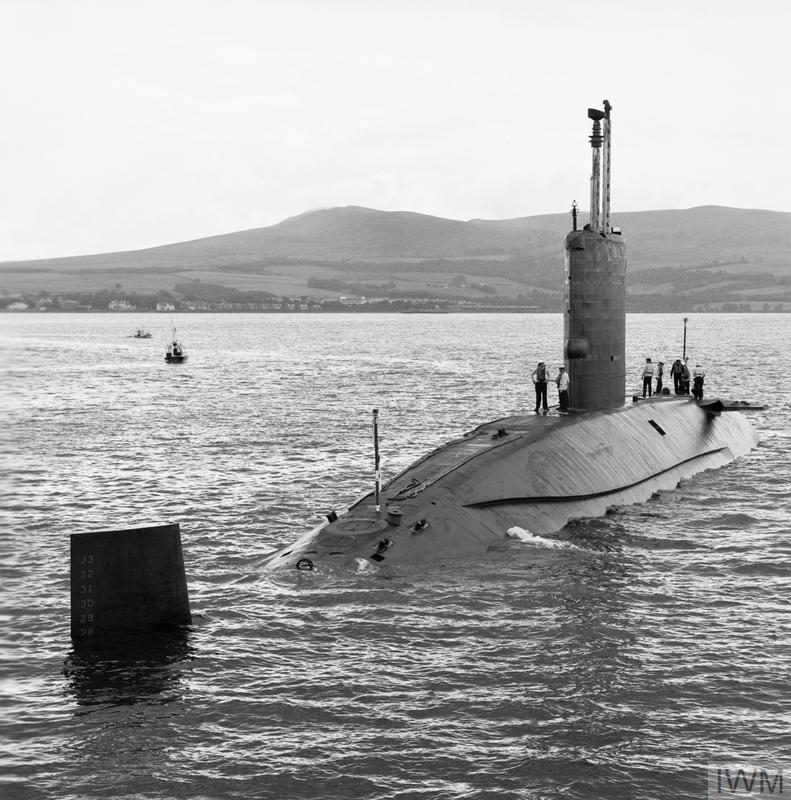
Conqueror
As the amphibious force closed in on the Falklands, Conqueror was forced to withdraw to deal with more communications problems, this time with the high-frequency trailing wire antenna. All three onboard had failed, and the first attempt to repair one, on May 21st, resulted in the wire getting wrapped around the propeller, causing major cavitation1 at any speed above 7 kts. A diver would have to go down and clear it, but the weather was too rough to surface for two days. Eventually, the wire was cleared, and Conqueror was back in the fight, which had finally moved ashore.
While the warships in Falkland Sound faced down Argentinian bombers, the men aboard the SSNs began to ask why they couldn't retaliate against the sinking of British warships in British territorial waters by sinking Argentinian warships in their territorial waters. This case was put to Cabinet by senior military officers, but the government refused to act for fear of diplomatic consequences. The SSNs spent the rest of the war on the prowl just off the coast, with the most notable incident befalling Spartan, which became entangled in a giant kelp bank, and only managed to work herself free by varying depth several times. At about this time, the first rotation in the force occurred, as Splendid was ordered home and replaced by Courageous, rushed out of a refit and equipped with the new Sub-Harpoon missile.
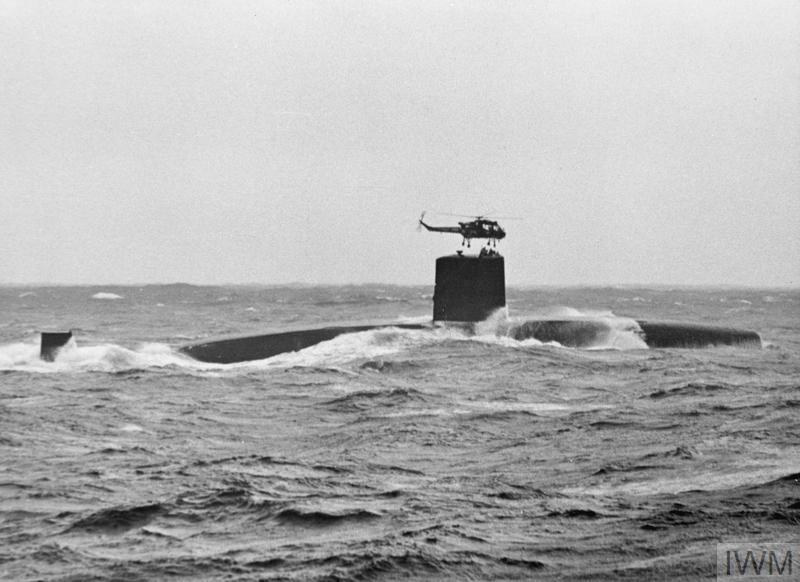
Courageous passes a sick sailor to a helicopter2
But while Argentina's surface fleet kept well inshore and out of danger, there was still a vital role for the SSNs to play. On May 17th, Valiant was stationed to the west, and her crew realized that they were directly on the flight path from the naval airbase at Rio Grande to the Falklands. When an airstrike was launched, her ESM mast would pick up their radars, and the satellite transmitter could beam a warning to the task force within minutes, helping to make up for the lack of airborne early warning available to the ships off the Falklands. She was soon joined in the mission by Conqueror, Spartan and Onyx, who covered different areas, and the warning became even more vital on June 8th, when a Chilean long-range radar that had been passing raid warnings to the British went down. The importance of the ELINT mission was graphically illustrated when Valiant was recalled from chasing an Argentine destroyer to resume her vigil, which netted over 300 warnings between May 17th and July 10th. The only incident happened on May 23rd, when Valiant discovered that she was in the area where planes which had turned back without dropping their bombs would jettison them after a series of explosions shook the boat. Her crew made sure she was under the outgoing track and not the return track after that.
A few days behind Courageous came the last submarine to serve with the British during the war, the diesel boat Onyx. Onyx had been dispatched early in the war to serve as a platform for special forces, but her passage from the UK to the Falklands took until May 31st, as Onyx couldn't simply submerge and cruise at high speed. Initially, she was tasked with supporting Operation Kettledrum, a plan to land an SBS team near the Argentine naval airbase at Puerto Deseado to destroy the Exocet missiles reportedly stored there. The entire scheme was as insane as the plan to attack the jets via C-130 abandoned earlier in the war, and it was scrapped a few days later when someone realized that Argentina had used the last of its air-launched Exocets in late May.3
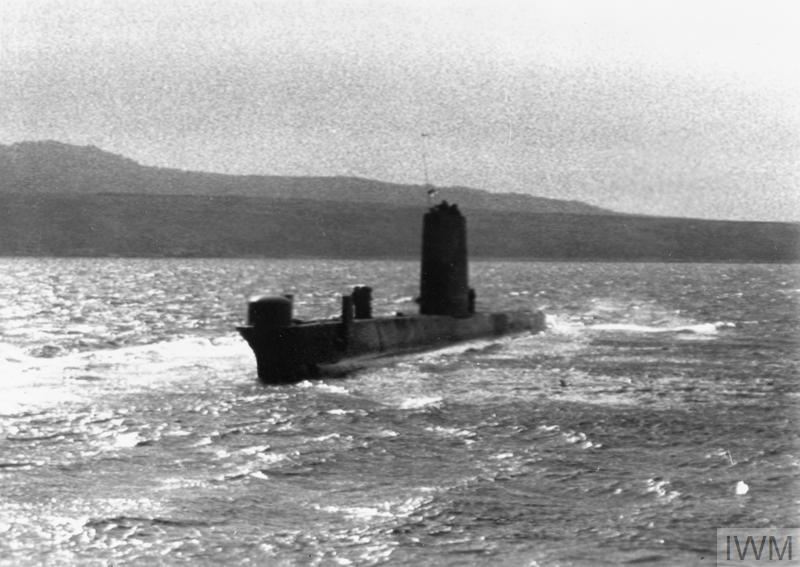
Onyx in San Carlos Water
Instead, Onyx was re-tasked with landing its SBS passengers on Weddell Island, the third-largest island in the Falklands, to deal with an Argentinian recon team that was supposedly supporting the air attacks. The first attempt, on June 5th, when awry when Onyx struck an uncharted pinnacle of rock during her approach, damaging the shutters for two of her bow torpedo tubes and trapping one torpedo in the tube. A second attempt avoided any rocks, but failed due to bad weather, which finally lifted the next day and allowed the SBS to go ashore, where they found no signs of any activity. After the end of the war, Onyx was tasked with scuttling the damaged landing ship Sir Galahad. The experience amply confirmed the wisdom of the captain of Conqueror in using the WWII-era Mk VIII torpedoes against the Belgrano. Twice, Onyx launched newer Tigerfish torpedoes against the hulk of Sir Galahad, and twice they failed to explode. Onyx finally finished the job with a Mk VIII, then headed for home. She was the last warship to return to the UK, tying up at Gosport on August 18th. The damaged torpedo was still in the tube, and engineers had to remove it with a live warhead still installed, and the potential for it to go off at any time.
The end of the fighting didn't bring an end to the impact of the war on the SSN fleet. The older boats, primarily Valiant, Warspite and Courageous, were regularly deployed to the South Atlantic as part of the British efforts to safeguard the islands. These patrols were long and boring, with the submarines spending much of their time off the Argentinian coast, monitoring signals. But a submarine that isn't known about isn't a very good deterrent, so they would occasionally find some fishing boats and expose their periscope to remind Buenos Aires what would happen to an invasion fleet. During one of these efforts, the Captain of Courageous became frustrated when the fishermen failed to spot his periscope or the other masts he raised to increase his signature. Eventually, he ordered the fin exposed, which certainly got their attention.
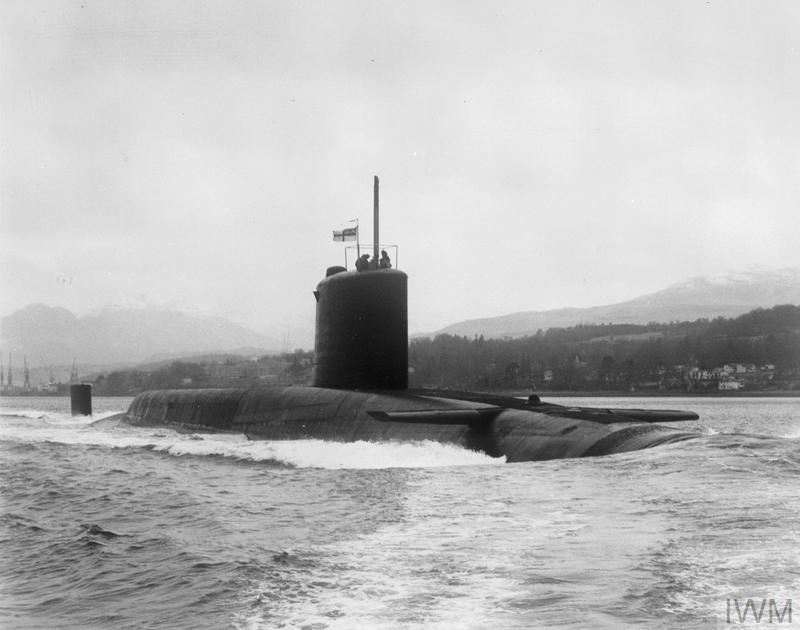
Resolution leaves on another patrol
The one part of the British submarine force that played no part in the Falklands was the Polaris force, tasked with deterring the Soviets from turning the Cold War hot. There were reports that the British had stationed an SSBN near Ascension Island, ready to launch a nuclear strike in the event of a major British loss. Other reports, including one broadcast by the BBC, put HMS Resolution, recently dispatched on patrol, off Buenos Aires. Her captain, when informed of this, "sent for the navigating officer and told him the good news". In reality, neither the RN nor the cabinet seriously considered the use of nuclear weapons against Argentina, although Thatcher herself apparently did contemplate it if things had gone very badly. The war did have an effect on Resolution's patrol, however, as the Soviets took advantage of the absence of so much of the British submarine force to flood the North Atlantic with their submarines, trying to hunt down Resolution. They were unsuccessful, thanks to evasive work by the British boat, which continued her record of undetected patrols.
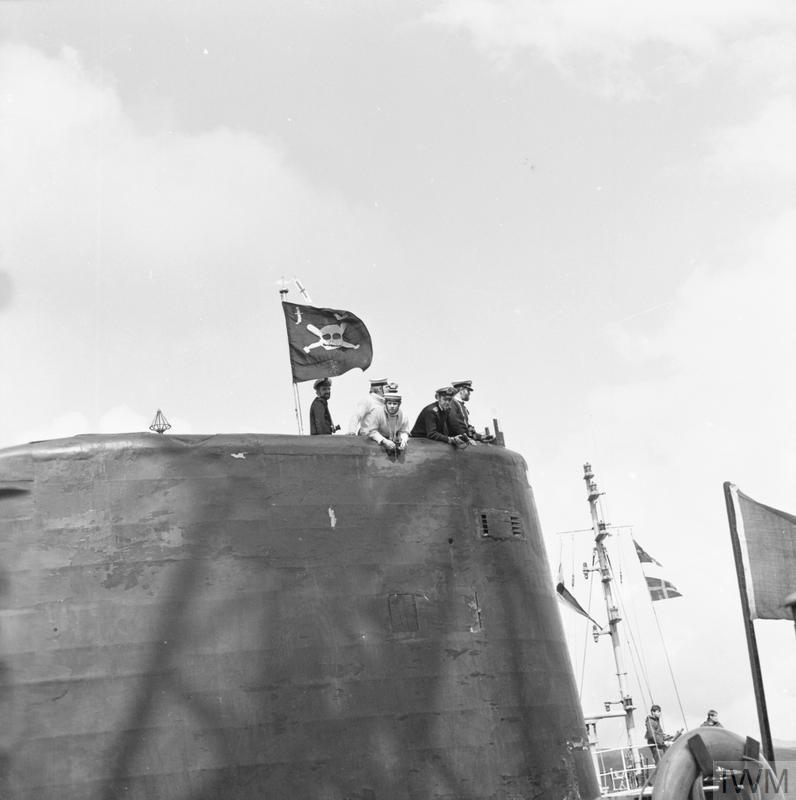
HMS Conqueror flies the Jolly Roger on her return home, as is traditional for RN submarines that have sunk an enemy ship
The experience of the British submarine force during and after the Falklands War was a clear demonstration of the utility of the modern nuclear submarine. Their force, traditionally focused on dealing with the Soviets, was able to swing on short notice to the South Atlantic, and reach it at speeds impossible for conventional ships, shutting down the majority of surface traffic by their very presence. Conqueror gave a graphic demonstration of the threat that SSNs pose to surface ships, and bottled up the Argentinian surface fleet, greatly simplifying the task of retaking the islands. And further deployments after the war made clear that any hostile action would likely be met with lethal consequences.
1 The formation of small bubbles that then collapse, primarily of interest because it makes a lot of noise. ⇑
2 This picture was taken a decade before the Falklands. ⇑
3 For some reason, Wikipedia keeps talking about a "myth" surrounding this, probably because some sources attribute this to the SAS and not the SBS. I disagree with this framing, as the existence of the operation is more important than which group was tasked with carrying it out. ⇑

Comments
Two consecutive shots failing to detonate (fortunately, on a non-threatening target) is an alarming level of unreliability for Tigerfish. It's a good thing the RN learned that in the Falklands rather than against the USSR.
Yeah, but it would have been perfectly normal for an early Mark 14 or G7A. Looking good is just a matter of picking the right baseline.
More seriously, did they not learn that you always, always do live-fire testing of your torpedoes?
In fairness to them, they did know there were serious problems with the Tigerfish. I believe it had actually failed its service trials, and was in use because the alternative was not having any sort of anti-submarine torpedo. Why do you think Conqueror used Mk 8s against the Belgrano? Sometimes, weapons development is hard, and you get it wrong.
Hey, the Mark 8 is a sort of anti-submarine torpedo. The only sort of heavyweight torpedo to ever sink a submerged sub, as far as I know.
But OK, there's only one Jimmy Launders, and he was pretty long in the tooth in 1982. I'd think the smart move would be to retask the British SSNs with NATO's anti-shipping and intelligence-gathering roles while they developed Spearfish, and let the Americans and French handle the ASW work.
From wiki, Tigerfish was about 40% reliable in tests. Can't be certain that the double failure against Sir Galahad wasn't reflective of bigger service problems, but it's likely that the British weren't totally toothless. And yes, point taken about the Mark 8.
Back in the late 1960s I had moved from aeronautical and electronic engineering with Bristol Aircraft Co. at Filton & Marconi to the GEC research establishment at Stanmore to work on an Anglo-American feasibility study on the possibility of geostationary satellites for navigation. However, as with the TSR2, the Wilson government cancelled both projects, so I was put with a team working on the sonar head for the Mk24 torpedo (later called Tigerfish). Quite a change from the delicate advanced lightweight technology I was used to. The torpedo stabilizing systems were basic, simple and able to withstand a kick from a sailor's boot. Early trials were fraught with problems I recall.
Apologies - found it on chapter 3. My old age again ! Best wishes Still good to have a chat if you wish 07796968615